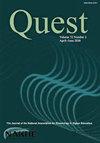Towards Equitable Communication of Kinesiology: A Critical Interpretive Synthesis of Readability Research
IF 1.7
3区 教育学
Q2 EDUCATION & EDUCATIONAL RESEARCH
引用次数: 6
Abstract
ABSTRACT Thirty-nine years ago, Bain and Poindexter (1981) implored higher educators of kinesiology to develop curricula that prepare students to use what they learn in practical ways. Lay resource material, however, often fails to meet metrics for adequate-to-optimal readability, regardless of who produces them. Research suggests that many people trained in kinesiology are not trained to communicate its content to lay adult audiences. Thus, the purpose of this study was to advance knowledge about this academic-practice-divide in kinesiology concerning plain language communication. Methodology for a critical interpretive synthesis was used to qualitatively synthesize readability research in kinesiology. Twenty-four peer-reviewed research articles met the study inclusion criteria, all published between 1992 and 2020 (M = 2010.1, SD = 8.8). There were 1550 materials studied across the articles. It was typical for these materials to run counter to plain language guidelines (i.e., low readability in one-or-more critical areas). Most materials were unsuitable for adults with basic health literacy or less – about half of the U.S. adult population. Following their presentation of results, the article authors often suggested one of six ways for improving lay material readability. Two major themes emerged from the qualitative synthesis of the articles: (a) how article authors discussed readability issues and what they proposed to be done to fix them, and (b) critiques of the research articles included in this study. The findings of this literature review shine light on the need to use readability research in kinesiology in programs that train people in an area of the discipline.面向运动机能学的公平交流:可读性研究的批判性解释性综合
39年前,Bain和Poindexter(1981)恳请运动机能学的高等教育工作者开发课程,使学生能够在实践中运用所学知识。然而,外行的资源材料往往不能满足适当到最佳可读性的标准,不管这些材料是谁制作的。研究表明,许多受过运动机能学训练的人并没有接受过将其内容传达给非专业成人观众的培训。因此,本研究的目的是增进对运动机能学中关于平实语言交流的学术-实践-分歧的认识。批判性解释综合的方法被用于定性地综合运动机能学的可读性研究。24篇同行评议的研究文章符合研究纳入标准,均发表于1992年至2020年之间(M = 2010.1, SD = 8.8)。文章中研究了1550种材料。典型的情况是,这些材料与简单的语言指导方针背道而驰(例如,在一个或多个关键领域的可读性较低)。大多数材料不适合具有基本健康知识或更低水平的成年人——约占美国成年人口的一半。在他们展示结果之后,文章作者通常会提出六种方法中的一种来提高外行材料的可读性。从文章的定性综合中出现了两个主要主题:(a)文章作者如何讨论可读性问题以及他们建议采取哪些措施来解决这些问题,以及(b)对本研究中包含的研究文章的评论。这篇文献综述的发现表明,在训练某一学科领域的人员的项目中,需要使用运动机能学的可读性研究。
本文章由计算机程序翻译,如有差异,请以英文原文为准。
求助全文
约1分钟内获得全文
求助全文
来源期刊

Quest
社会科学-运动科学
CiteScore
4.50
自引率
14.30%
发文量
16
期刊介绍:
Quest is the official journal of the National Association for Kinesiology in Higher Education (NAKHE). It is the leading journal for interdisciplinary scholarship for professionals in kinesiology in higher education. Quest provides a public forum for scholarship, creative thought, and research relevant to a broad range of interests held by faculty and leaders in higher education today.
Quest publishes: 1) manuscripts that address issues and concerns relevant and meaningful to the field of kinesiology; 2) original research reports that address empirical questions that are contextualized within higher education and hold significance to a broad range of faculty and administrators in kinesiology; and 3) reviews of literature and/or research of interest to one or more sub-disciplines in kinesiology. Quest does not publish papers focused on sport (e.g., amateur, collegiate, professional) that are contextualized outside of kinesiology in higher education.
 求助内容:
求助内容: 应助结果提醒方式:
应助结果提醒方式:


